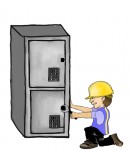Hit C. Punch in “5555.” Press the lock key.
That’s a dining hall locker procedure I’m sure many of us use. If the locker locks, our search is over. If not, we try again.
At the De Neve dining hall, my search for a functional locker averages six iterations of the procedure. Lately, however, it’s been taking somewhere close to 12, and I can assure you it’s not because my short-term memory has gotten worse.
The truth is, it’s because the dining hall lockers have failed us, again.
The current locker system is not sustainable for two reasons: It depends on students and staff to report locker failures, and it has a lot of room for delay in the locker repair process.
While it’s typical for a handful of lockers in any dining hall to not function properly, starting nearly a month back, an unusually large percentage of the De Neve dining hall lockers have broken down. The fact that the lockers have not yet been repaired sheds light on the fact that in its current state, the dining hall locker system cannot cope with a system failure.
The current system of posting signs that request students and staff to report dysfunctional lockers to the dining hall host stations fails to account for the fact that when students come to the dining hall, their focus is on eating, not on the lockers.
Rather than relying on students and staff to go to the host stations and report broken lockers, it would be much more effective if the lockers were primarily self-reporting and able to indicate whether they are functional. This would not only introduce independence to the reporting procedure, but also allow for more proactive action in repairing broken lockers.
There are several ideas that can be used, but the simplest would be to use colored stickers. The system is as follows:
Each locker would be equipped with several small, red-colored stickers that would be secured to a wax paper sheet on the back side of the locker door. When a student discovers a dysfunctional locker, he or she would peel off a sticker and paste it on the outer edge of the locker door. The stickers would be adhesive enough to withstand the usual wear and tear of locker operation, so they would continue to stick long past the time they are adhered.
Such a system would not only allow for students to know that a certain locker isn’t working, which could potentially decrease crowding around dysfunctional lockers, but would also give dining hall management an indication of what percentage of lockers are dysfunctional at any given time.
A dysfunctional locker need only be marked once with a sticker before it self-reports its status to students and staff. This, in turn, would be more effective in allowing management to take swift action in getting the lockers repaired, which could potentially reduce delay in the locker repair process.
Additionally, the solution would be very efficient. For reference, a pack of 1,008 red-colored circular stickers costs $6.99 on Office Depot’s online store.
UCLA Dining Services said in an email statement that Housing and Hospitality Services staff assess the state of the dining hall lockers daily and contact on-campus housing maintenance staff to repair lockers when they find problems.
“Students are encouraged to report broken lockers when they encounter problems,” the statement added.
Despite these assertions, it’s clear the current system of handling broken lockers is not able to hold up to all of its claims. The fact that there are a notable number of dysfunctional lockers in De Neve is proof of that.
Requesting students and staff to report locker failures to the host station seems cheaper and easier to implement than other solutions for notifying dining hall management about broken lockers; however, it fails considerably in doing so.
The likelihood of a student reporting a locker failure is quite low, considering the fact that the student would just find a locker that functions properly and forget about the broken one.
Likewise, the chances of dining hall staff reporting dysfunctional lockers are also quite slim, given that a majority of the staff spend a great deal of their time in the dining halls themselves, not in the outer locker areas.
Taking into account these defects of the current locker system and the cost of repairing all the broken lockers in the dining halls – which UCLA Dining Services said in its official statement to be on the order of $90 per replacement lock – it would potentially be a better use of money to just invest in a set of new lockers that are more durable and address the aforementioned two issues.
However, considering the reality of installing new lockers, the colored-sticker solution would be far more reasonable.
Regardless of the solution implemented, it’s essential that the dining halls have functional lockers. It’s only fair that they provide students with facilities to safely secure their backpacks and belongings when they restrict students from bringing them in.
